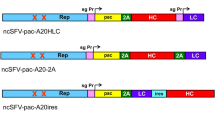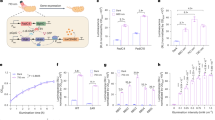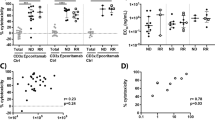Abstract
Here, we investigated the antitumor effect of adenovirus-mediated gene transfer of LIGHT, the tumor-necrosis factor (TNF) superfamily member also known as TNFSF14, in the murine A20 B-cell lymphoma. LIGHT gene modification resulted in upregulated expression of Fas and the accessory molecule—intercellular adhesion molecule-1 (ICAM-1) on A20 cells and led to enhanced A20 cell apoptosis. LIGHT-modified A20 cells effectively stimulated the proliferation of T lymphocytes and interferon (IFN)-γ production in vitro. Immunization of BALB/c mice with a LIGHT-modified A20 cell vaccine efficiently elicited protective immunity against challenge with the parental tumor cell line. Adenovirus-mediated gene transfer of LIGHT by intratumoral injection exerted a very potent antitumor effect against pre-existing A20 cell lymphoma in BALB/c mice. This adenovirus-mediated LIGHT therapy induced substantial splenic natural killer (NK) and cytotoxic T lymphocyte (CTL) activity, enhanced tumor infiltration by inflammatory cells and increased chemokine expression of CC chemokine ligand 21 (CCL21), IFN-inducible protein-10 (IP-10) and monokine induced by IFN-γ (Mig) from tumor tissues. Thus, adenovirus-mediated LIGHT therapy might have potential utility for the prevention and treatment of B-cell lymphoma.
This is a preview of subscription content, access via your institution
Access options
Subscribe to this journal
Receive 12 digital issues and online access to articles
$119.00 per year
only $9.92 per issue
Buy this article
- Purchase on SpringerLink
- Instant access to full article PDF
Prices may be subject to local taxes which are calculated during checkout






Similar content being viewed by others
References
LaCasce AS, Kho ME, Friedberg JW, Niland JC, Abel GA, Rodriguez MA et al. Comparison of referring and final pathology for patients with non-Hodgkin's lymphoma in the National Comprehensive Cancer Network. J Clin Oncol 2008; 26: 5107–5112.
Seshadri T, Stakiw J, Pintilie M, Keating A, Crump M, Kuruvilla J . Utility of subsequent conventional dose chemotherapy in relapsed/refractory transplant-eligible patients with diffuse large B-cell lymphoma failing platinum-based salvage chemotherapy. Hematology 2008; 13: 261–266.
Bernstein SH, Unger JM, Leblanc M, Friedberg J, Miller TP, Fisher RI . Natural history of CNS relapse in patients with aggressive non-Hodgkin's lymphoma: a 20-year follow-up analysis of SWOG 8516 – the Southwest Oncology Group. J Clin Oncol 2009; 27: 114–119.
Cheson BD, Leonard JP . Monoclonal antibody therapy for B-cell non-Hodgkin's lymphoma. N Engl J Med 2008; 359: 613–626.
Meziane el K, Bhattacharyya T, Armstrong AC, Qian C, Hawkins RE, Stern PL et al. Use of adenoviruses encoding CD40L or IL-2 against B cell lymphoma. Int J Cancer 2004; 111: 910–920.
Ulaner GA, Colletti PM, Conti PS . B-cell non-Hodgkin lymphoma: PET/CT evaluation after 90Y-ibritumomab tiuxetan radioimmunotherapy – initial experience. Radiology 2008; 246: 895–902.
Sapra P, Allen TM . Improved outcome when B-cell lymphoma is treated with combinations of immunoliposomal anticancer drugs targeted to both the CD19 and CD20 epitopes. Clin Cancer Res 2004; 10: 2530–2537.
Hurwitz AA, Kwon ED, van Elsas A . Costimulatory wars: the tumor menace. Curr Opin Immunol 2000; 12: 589–596.
Celli S, Garcia Z, Beuneu H, Bousso P . Decoding the dynamics of T cell-dendritic cell interactions in vivo. Immunol Rev 2008; 221: 182–187.
Schultze JL, Cardoso AA, Freeman GJ, Seamon MJ, Daley J, Pinkus GS et al. Follicular lymphomas can be induced to present alloantigen efficiently: a conceptual model to improve their tumor immunogenicity. Proc Natl Acad Sci USA 1995; 92: 8200–8204.
Vyth-Dreese FA, Dellemijn TA, van Oostveen JW, Feltkamp CA, Hekman A . Functional expression of adhesion receptors and costimulatory molecules by fresh and immortalized B-cell non-Hodgkin's lymphoma cells. Blood 1995; 85: 2802–2812.
Stopeck AT, Gessner A, Miller TP, Hersh EM, Johnson CS, Cui H et al. Loss of B7.2 (CD86) and intracellular adhesion molecule 1 (CD54) expression is associated with decreased tumor-infiltrating T lymphocytes in diffuse B-cell large-cell lymphoma. Clin Cancer Res 2000; 6: 3904–3909.
Briones J, Timmerman J, Levy R . In vivo antitumor effect of CD40L-transduced tumor cells as a vaccine for B-cell lymphoma. Cancer Res 2002; 62: 3195–3199.
Costello RT, Mallet F, Barbarat B, Schiano de Colella JM, Sainty D, Sweet RW et al. Stimulation of non-Hodgkin's lymphoma via HVEM: an alternate and safe way to increase Fas-induced apoptosis and improve tumor immunogenicity. Leukemia 2003; 17: 2500–2507.
Mauri DN, Ebner R, Montgomery RI, Kochel KD, Cheung TC, Yu GL et al. LIGHT, a new member of the TNF superfamily, and lymphotoxin alpha are ligands for herpesvirus entry mediator. Immunity 1998; 8: 21–30.
Zhai Y, Guo R, Hsu TL, Yu GL, Ni J, Kwon BS et al. LIGHT, a novel ligand for lymphotoxin beta receptor and TR2/HVEM induces apoptosis and suppresses in vivo tumor formation via gene transfer. J Clin Invest 1998; 102: 1142–1151.
Tamada K, Shimozaki K, Chapoval AI, Zhai Y, Su J, Chen SF et al. LIGHT, a TNF-like molecule, costimulates T cell proliferation and is required for dendritic cell-mediated allogeneic T cell response. J Immunol 2000; 164: 4105–4110.
Tamada K, Shimozaki K, Chapoval AI, Zhu G, Sica G, Flies D et al. Modulation of T-cell-mediated immunity in tumor and graft-versus-host disease models through the LIGHT co-stimulatory pathway. Nat Med 2000; 6: 283–289.
Yu P, Lee Y, Liu W, Chin RK, Wang J, Wang Y et al. Priming of naive T cells inside tumors leads to eradication of established tumors. Nat Immunol 2004; 5: 141–149.
Wang Q, Yu H, Ju DW, He L, Pan JP, Xia DJ et al. Intratumoral IL-18 gene transfer improves therapeutic efficacy of antibody-targeted superantigen in established murine melanoma. Gene Ther 2001; 8: 542–550.
Zoll B, Lefterova P, Csipai M, Finke S, Trojaneck B, Ebert O et al. Generation of cytokine-induced killer cells using exogenous interleukin-2, -7 or -12. Cancer Immunol Immunother 1998; 47: 221–226.
Nam JS, Terabe M, Kang MJ, Chae H, Voong N, Yang YA et al. Transforming growth factor beta subverts the immune system into directly promoting tumor growth through interleukin-17. Cancer Res 2008; 68: 3915–3923.
Fuertes MB, Girart MV, Molinero LL, Domaica CI, Rossi LE, Barrio MM et al. Intracellular retention of the NKG2D ligand MHC class I chain-related gene A in human melanomas confers immune privilege and prevents NK cell-mediated cytotoxicity. J Immunol 2008; 180: 4606–4614.
Lu B, Finn OJ . T-cell death and cancer immune tolerance. Cell Death Differ 2008; 15: 70–79.
Ye Q, Fraser CC, Gao W, Wang L, Busfield SJ, Wang C et al. Modulation of LIGHT-HVEM costimulation prolongs cardiac allograft survival. J Exp Med 2002; 195: 795–800.
Scheu S, Alferink J, Potzel T, Barchet W, Kalinke U, Pfeffer K . Targeted disruption of LIGHT causes defects in costimulatory T cell activation and reveals cooperation with lymphotoxin beta in mesenteric lymph node genesis. J Exp Med 2002; 195: 1613–1624.
Mortarini R, Scarito A, Nonaka D, Zanon M, Bersani I, Montaldi E et al. Constitutive expression and costimulatory function of LIGHT/TNFSF14 on human melanoma cells and melanoma-derived microvesicles. Cancer Res 2005; 65: 3428–3436.
Yu P, Lee Y, Wang Y, Liu X, Auh S, Gajewski TF et al. Targeting the primary tumor to generate CTL for the effective eradication of spontaneous metastases. J Immunol 2007; 179: 1960–1968.
Diamond MS, Staunton DE, Marlin SD, Springer TA . Binding of the integrin Mac-1 (CD11b/CD18) to the third immunoglobulin-like domain of ICAM-1 (CD54) and its regulation by glycosylation. Cell 1991; 65: 961–971.
Lebedeva T, Dustin ML, Sykulev Y . ICAM-1 co-stimulates target cells to facilitate antigen presentation. Curr Opin Immunol 2005; 17: 251–258.
Dennig D, Lacerda J, Yan Y, Gasparetto C, O'Reilly RJ . ICAM-1 (CD54) expression on B lymphocytes is associated with their costimulatory function and can be increased by coactivation with IL-1 and IL-7. Cell Immunol 1994; 156: 414–423.
Hisada M, Yoshimoto T, Kamiya S, Magami Y, Miyaji H, Yoneto T et al. Synergistic antitumor effect by coexpression of chemokine CCL21/SLC and costimulatory molecule LIGHT. Cancer Gene Ther 2004; 11: 280–288.
Fan Z, Yu P, Wang Y, Wang Y, Fu ML, Liu W et al. NK-cell activation by LIGHT triggers tumor-specific CD8+ T-cell immunity to reject established tumors. Blood 2006; 107: 1342–1351.
Sallusto F, Mackay CR, Lanzavecchia A . The role of chemokine receptors in primary, effector, and memory immune responses. Annu Rev Immunol 2000; 18: 593–620.
Dufour JH, Dziejman M, Liu MT, Leung JH, Lane TE, Luster AD . IFN-gamma-inducible protein 10 (IP-10; CXCL10)-deficient mice reveal a role for IP-10 in effector T cell generation and trafficking. J Immunol 2002; 168: 3195–3204.
Zhang R, Tian L, Chen LJ, Xiao F, Hou JM, Zhao X et al. Combination of MIG (CXCL9) chemokine gene therapy with low-dose cisplatin improves therapeutic efficacy against murine carcinoma. Gene Ther 2006; 13: 1263–1271.
Acknowledgements
We thank Professor Yangxin Fu of The University of Chicago for the gift of Ad LIGHT. This work was supported by grants from the National Natural Science Foundation of China (30328011 and 30872377), the National Basic Research Program of China (2004CB518802) and the Science and Technology Department of Zhejiang Province (2008C23044). We would like to acknowledge Jianping Pan and Dajing Xia for helpful suggestions and discussions.
Author information
Authors and Affiliations
Corresponding author
Rights and permissions
About this article
Cite this article
Hu, G., Liu, Y., Li, H. et al. Adenovirus-mediated LIGHT gene modification in murine B-cell lymphoma elicits a potent antitumor effect. Cell Mol Immunol 7, 296–305 (2010). https://doi.org/10.1038/cmi.2010.15
Received:
Revised:
Accepted:
Published:
Issue date:
DOI: https://doi.org/10.1038/cmi.2010.15
Keywords
This article is cited by
-
Immunogenic senescence sensitizes lung cancer to LUNX-targeting therapy
Cancer Immunology, Immunotherapy (2022)
-
Lymphotoxin signalling in tertiary lymphoid structures and immunotherapy
Cellular & Molecular Immunology (2017)
-
Gene therapy of gastric cancer using LIGHT-secreting human umbilical cord blood-derived mesenchymal stem cells
Gastric Cancer (2013)
-
Cloning, expression, and characterization of TNFSF14 (LIGHT) gene in mefugu, Takifugu obscurus
Molecular and Cellular Biochemistry (2013)



